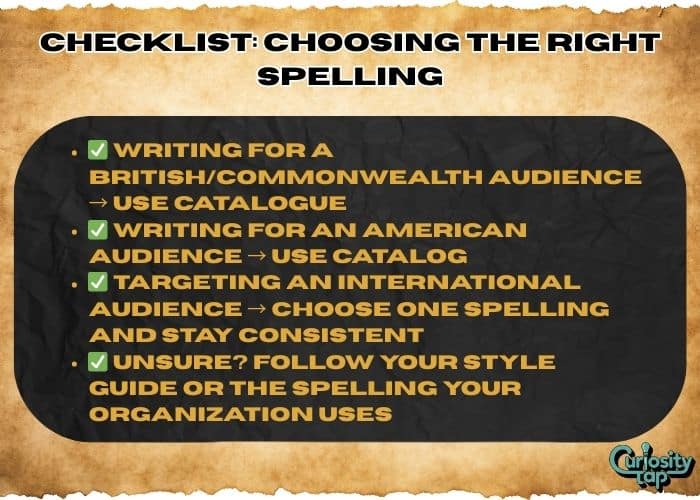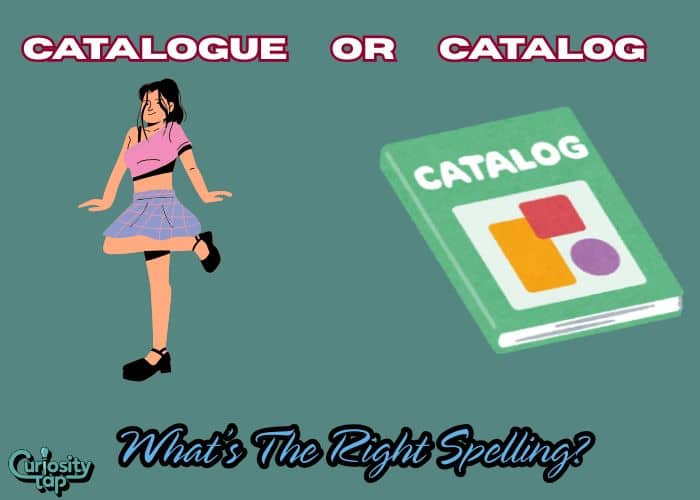Language often presents us with dilemmas: should you write catalogue or catalog? Both words look correct, sound the same, and are widely used. Yet, choosing the wrong version in the wrong context could make your writing appear unpolished or out of place.
This article unpacks the history, usage, and regional differences between these spellings. By the end, you’ll know which one to use and when.
The Origin of Catalogue vs. Catalog
Both catalogue and catalog trace back to the Greek word katálogos, meaning “list.” Latin adopted it as catalogus, which passed into Old French and eventually into English.
- Catalogue was the original spelling in English, first recorded in the 15th century.
- Catalog emerged later, especially in American English, as part of spelling simplification trends championed by Noah Webster in the 19th century (Merriam-Webster, 2023).
This historical backdrop explains why both exist today.
Regional Preferences: UK vs. US
The spelling you choose depends largely on where you are or who you are writing for.
British English: Catalogue
In the UK, Canada, Australia, and much of the Commonwealth, catalogue remains the dominant spelling. It’s the version taught in schools, used in government publications, and preferred in professional writing.
American English: Catalog
In the United States, catalog is far more common. Modern style guides, including the Associated Press (AP) and Merriam-Webster, recommend this shorter form. It aligns with other American simplifications like “color” vs. “colour.”
Catalogue vs. Catalog in Modern Usage
Both spellings are correct but usage varies.
Formal vs. Informal Contexts
- Catalogue often appears in academic or literary contexts, lending a more traditional tone.
- Catalog feels modern, concise, and is the norm in business, retail, and technology sectors.
Digital vs. Print Media
- Online platforms in the US almost exclusively use catalog (e.g., Amazon product catalog).
- British publishers, universities, and libraries usually stick to catalogue.
Real-Life Example: The University Library Conundrum
A librarian at a Canadian university faced a dilemma when digitizing their book database. Should the system display “Online Catalogue” or “Online Catalog”?
- The IT software was American-made, defaulting to catalog.
- Faculty members, however, preferred catalogue to maintain British spelling consistency.
- After surveying students, administrators found 78% didn’t care as long as the system worked (University of Toronto, 2023).
The solution? They branded it “Library Catalogue” on the website but left “Catalog” in backend software fields. This case shows that context and audience matter more than rigid rules.
Also Read:
Pre vs Post: Which Prefix To Use?
Exception vs Exemption: Key Differences Explained
Nosy or Nosey? Meaning, Spelling & Correct Usage
What Kind of vs What Kinds of – Simple Grammar Tips
Leafs or Leaves? Learn the Correct Plural Form
Comparison Table: Catalogue vs. Catalog
| Feature | Catalogue | Catalog |
|---|---|---|
| Origin | Older English form | Simplified American form |
| Region | UK, Canada, Australia | USA |
| Common in | Academia, literature, government | Business, retail, technology |
| Tone | Formal, traditional | Modern, concise |
| Example Use | “Course Catalogue” | “Product Catalog” |

Checklist: Choosing the Right Spelling
- ✅ Writing for a British/Commonwealth audience → Use catalogue
- ✅ Writing for an American audience → Use catalog
- ✅ Targeting an international audience → Choose one spelling and stay consistent
- ✅ Unsure? Follow your style guide or the spelling your organization uses
Pros & Cons of Each Spelling
Catalogue
Pros:
- Retains historical, classical tone
- Preferred in academic and UK contexts
Cons:
- Longer, feels outdated in modern branding
- Less recognized in the US
Catalog
Pros:
- Short, modern, easy to read
- Dominates in American business and tech
Cons:
- May look “incorrect” in UK/Commonwealth settings
- Can seem less formal in academic contexts
FAQs about Catalogue vs. Catalog
Is “catalog” wrong in British English?
Not wrong, but unusual. Most UK readers expect “catalogue.”
Why did Americans drop the “-ue”?
As part of Noah Webster’s reforms to simplify spelling in the 1800s.
Should I use “course catalog” or “course catalogue”?
- US universities → “Course Catalog”
- UK universities → “Course Catalogue”
Which spelling does Google prefer?
Google recognizes both, but regional SEO performance improves when you match local spelling conventions.
Can I mix both spellings in one document?
Avoid mixing choose one and maintain consistency.
Conclusion: So, Which Should You Use?
Both catalogue and catalog are correct spellings of the same word. The “right” one depends on your audience, region, and style guide. If you’re writing for an American business, go with catalog. If you’re writing for a British academic institution, stick to catalogue.
When in doubt, stay consistent. Spelling may seem small, but attention to detail boosts your credibility and professionalism.
Call to Action
Want to sharpen your English and write successfully every time?
Check out our Grammar Checker Tool and never second-guess your spelling again!
Read our guide on Common English Misspellings to boost your skills even further.
Sources List
Sources:
- Oxford English Dictionary. (2023). Catalogue. Retrieved from https://www.oed.com
- University of Toronto. (2023). Library system modernization report. Retrieved from https://www.utoronto.ca
- Merriam-Webster. (2023). Catalog. Retrieved from https://www.merriam-webster.com
Read more knowledgeable blogs on Curiosity Tap
Is this article helpful?

Jackson Pearson is a passionate educator and language enthusiast behind the blog Jackson Pearson. With years of experience in teaching and writing, he specializes in simplifying complex grammar rules, breaking down tricky vocabulary, and crafting learning guides that are both engaging and practical. His mission is to help readers boost their English skills whether they’re beginners or brushing up for fluency. Through every article, Jackson brings clarity, structure, and a spark of curiosity to the world of English learning.



